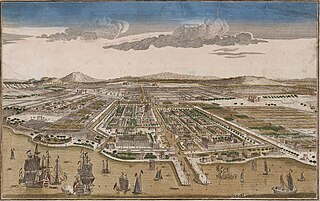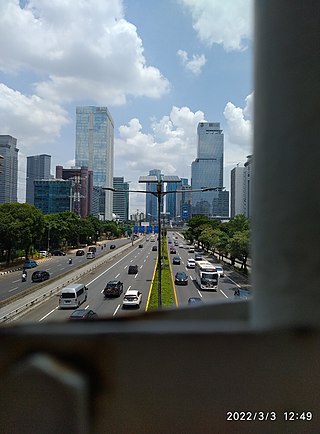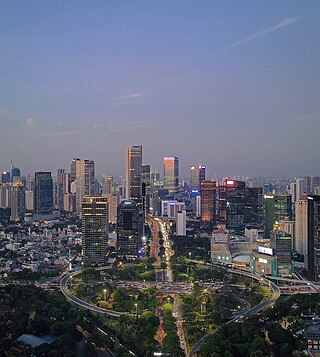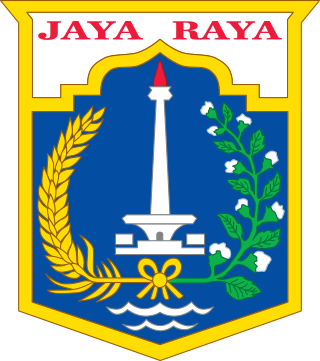
Menteng is a district in the administrative city of Central Jakarta, Indonesia. Menteng is surrounded by the districts of Senen and Matraman to the east, Tebet and Setiabudi to the south, Tanah Abang to the west, and Gambir to the north. Menteng is bound by the West Flood Canal to the west, Ciliwung River to the south and east, and Kebon Sirih Road to the north. Menteng is the district seat of the Central Jakarta government.

Kebayoran Baru is a district in the administrative city of South Jakarta, Indonesia. The name was derived from a planned satellite city of the same name which was developed in the post-war period. Kebayoran Baru was the last residential area to be developed by the Dutch colonial administration. The urban planning was laid in a concept of the Garden city movement, consisting of a well-planned residential area, a shopping center, and a business district, supported with civic facilities such as schools, places of worship, hospitals, and parks. Today, the district is home to many important government institutions, such as the Indonesia Stock Exchange building, the ASEAN Headquarters building, the National Police headquarters, and the City Hall of South Jakarta. Sudirman Central Business District is also located in the district.

Jakarta is Indonesia's capital and largest city. Located on an estuary of the Ciliwung River, on the northwestern part of Java, the area has long sustained human settlement. Historical evidence from Jakarta dates back to the 4th century CE, when it was a Hindu settlement and port. The city has been sequentially claimed by the Indianized kingdom of Tarumanegara, the Hindu Kingdom of Sunda, the Muslim Sultanate of Banten, and by Dutch, Japanese and Indonesian administrations. The Dutch East Indies built up the area before it was taken during World War II by the Empire of Japan and finally became independent as part of Indonesia.

Jakarta Inner Ring Road, also known as the Jakarta Inner-City Toll Road is a toll road circling the city of Jakarta, Indonesia. On northern and the eastern section, the toll road is grade-separated with the Sosrobahu road construction technique. The toll road is operated by PT Jasa Marga (Persero) Tbk, a state-owned enterprise, and PT Citra Marga Nushapala Persada Tbk (CMNP), founded by the Suharto family which is also the initiator of the Metro Manila Skyway.
Senayan is an administrative village at Kebayoran Baru subdistrict, South Jakarta, Indonesia. The post code is 12190.

Selamat Datang Monument, also known as the Monumen Bundaran HI or Monumen Bunderan HI, is a monument located in Central Jakarta, Indonesia. Completed in 1962 by sculptor Edhi Sunarso, the Selamat Datang Monument is one of the historic landmarks of Jakarta.

The Heroes Monument, popularly known as Tugu Tani is a bronze statue and important landmark located in Jakarta, Indonesia. The monument celebrates the heroes of the struggles of the Indonesian nation symbolized by a peasant youth wearing a caping with a rifle on his shoulder, a mother behind him offering him a dish of rice. The caping is a traditional farmer's hat in Indonesia, thus the statue is also referred as the Farmer's Monument.
The following is a timeline of the history of the city of Jakarta, Indonesia.

Jalan M.H. Thamrin or Jalan Thamrin is a major thoroughfare in Jakarta, Indonesia. The road is located at the center of Jakarta, running from the north end of Jalan Jenderal Sudirman at West Flood Canal at the south end to the roundabout near Arjuna Wijaya Statue Jakarta at the north end. Developed in the 1950s, the road was a landmark of post-colonial Indonesia and continues to have a prominent importance in Jakarta.

Jalan Jenderal Sudirman or Jalan Sudirman is a major thoroughfare in Jakarta, Indonesia. Named after Indonesian national hero Sudirman, the road runs from Patung Pemuda Membangun at the south end to the bridge of the West Flood Canal to the north, where it meets Jalan M.H. Thamrin. The road had been built between 1949 and 1953 to connect Central Jakarta with Kebayoran Baru.

Al-Azhar Great Mosque is a mosque located in Jalan Sisingamangaraja, Kebayoran Baru, Jakarta. The mosque was constructed between 1953 and 1958. It was originally known simply as Mesjid Agung. It was Jakarta's largest mosque when it was built until it was surpassed by the Istiqlal Mosque which was completed in 1978. Al-Azhar mosque and the mosque complex is best known for its educational works.

Jalan Jenderal Gatot Subroto(Gatot Subroto Avenue) is one of the major roads in Jakarta, Indonesia. The road starts from Dirgantara statue in South Jakarta, which crosses 10 administrative villages and ends at Slipi, Central Jakarta. The road is named after National Hero of Indonesia General Gatot Subroto. The road was constructed in 1960s. The road runs parallel with Jakarta Inner Ring Road. The location of the road is within the Golden Triangle CBD of Jakarta. Many important office buildings and skyscrapers are situated along the road.
The Golden Triangle of Jakarta or can also be referred to as Medan Merdeka–Thamrin–Sudirman Axis or Sudirman–Thamrin–Kuningan Axis, is a roughly triangular area in the center of Jakarta, Indonesia, extending from Central Jakarta to South Jakarta. Most of the city's foreign embassies and tallest skyscrapers are located in the area, which is the main CBD of Jakarta.

Semanggi Interchange or commonly known as Semanggi Bridge is a major road interchange in Jakarta, Indonesia which consists of a cloverleaf interchange —the first, and until the 1990s the only, of its kind in Indonesia—and a partial turbine interchange. Two main roads of the city Gatot Subroto Road and Sudirman Road intersect at this interchange. Initially completed in 1962 as part of several projects intended to be completed before the 1962 Asian Games, the interchange is a landmark and an important part of the Golden Triangle of Jakarta.

Dirgantara Monument, also known as Gatot Kaca Monument after the Javanese wayang figure, is a monument located in Jakarta, Indonesia. It is also known as Tugu Pancoran, after tugu a word for statue and pedestal, and the South Jakarta subdistrict of Pancoran, where it is located. The monument was commissioned by President Sukarno in 1964 as a tribute to the Indonesian Air Force and early Indonesian aviators who flew against the Dutch to achieve independence.

West Irian Liberation Monument is a postwar modernist monument located in Jakarta, Indonesia. It is located in the center of Lapangan Banteng in Sawah Besar, Central Jakarta. Sukarno, then President of Indonesia, commissioned the monument in 1963 following the West New Guinea dispute in which Indonesia received the territory of Western New Guinea from the Netherlands.

BNI City station is a station for the Soekarno-Hatta Airport Rail Link and KAI Commuter service. Bank Negara Indonesia (BNI) holds the naming rights for the station, which was known as Sudirman Baru station during construction period. The station is located in Central Jakarta, on the north bank of West Flood Canal, about a hundred meters from Sudirman Commuter Rail station. The station is part of Dukuh Atas TOD.

The following outline is provided as an overview of and topical guide to Jakarta:

Senayan Station is a rapid transit station on the North-South Line of the Jakarta MRT in Jakarta, Indonesia. Located on Jl. Jendral Sudirman, it is the first underground station on the MRT. It is located between the Istora Mandiri and ASEAN stations, and has the station code of SNY. The station is located close to the Ratu Plaza Shopping Center, within walking distance of the malls of Senayan City and Plaza Senayan.

Dukuh Atas TOD is a transit-oriented development area between Central Jakarta and South Jakarta, Indonesia. This is built as part of constructing several other transit oriented development across Jakarta to facilitate commuters to transfer between different mode of public transportation.

















